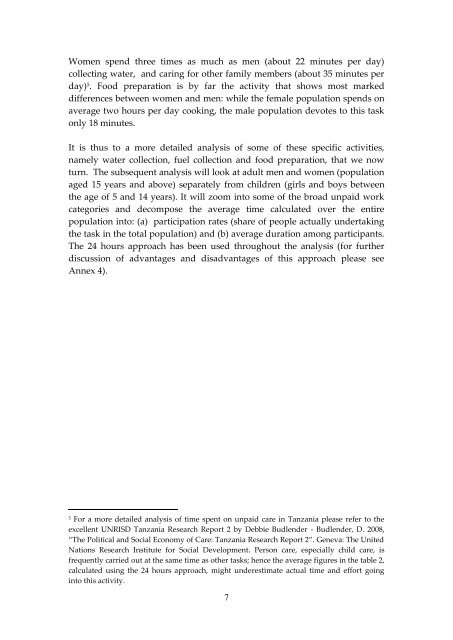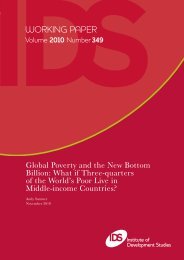Patterns of time use in Tanzania: how to make public investment in ...
Patterns of time use in Tanzania: how to make public investment in ...
Patterns of time use in Tanzania: how to make public investment in ...
Create successful ePaper yourself
Turn your PDF publications into a flip-book with our unique Google optimized e-Paper software.
Women spend three <strong>time</strong>s as much as men (about 22 m<strong>in</strong>utes per day)<br />
collect<strong>in</strong>g water, and car<strong>in</strong>g for other family members (about 35 m<strong>in</strong>utes per<br />
day) 5 . Food preparation is by far the activity that s<strong>how</strong>s most marked<br />
differences between women and men: while the female population spends on<br />
average two hours per day cook<strong>in</strong>g, the male population devotes <strong>to</strong> this task<br />
only 18 m<strong>in</strong>utes.<br />
It is thus <strong>to</strong> a more detailed analysis <strong>of</strong> some <strong>of</strong> these specific activities,<br />
namely water collection, fuel collection and food preparation, that we now<br />
turn. The subsequent analysis will look at adult men and women (population<br />
aged 15 years and above) separately from children (girls and boys between<br />
the age <strong>of</strong> 5 and 14 years). It will zoom <strong>in</strong><strong>to</strong> some <strong>of</strong> the broad unpaid work<br />
categories and decompose the average <strong>time</strong> calculated over the entire<br />
population <strong>in</strong><strong>to</strong>: (a) participation rates (share <strong>of</strong> people actually undertak<strong>in</strong>g<br />
the task <strong>in</strong> the <strong>to</strong>tal population) and (b) average duration among participants.<br />
The 24 hours approach has been <strong>use</strong>d throughout the analysis (for further<br />
discussion <strong>of</strong> advantages and disadvantages <strong>of</strong> this approach please see<br />
Annex 4).<br />
5 For a more detailed analysis <strong>of</strong> <strong>time</strong> spent on unpaid care <strong>in</strong> <strong>Tanzania</strong> please refer <strong>to</strong> the<br />
excellent UNRISD <strong>Tanzania</strong> Research Report 2 by Debbie Budlender - Budlender, D. 2008,<br />
‚The Political and Social Economy <strong>of</strong> Care: <strong>Tanzania</strong> Research Report 2‛. Geneva: The United<br />
Nations Research Institute for Social Development. Person care, especially child care, is<br />
frequently carried out at the same <strong>time</strong> as other tasks; hence the average figures <strong>in</strong> the table 2,<br />
calculated us<strong>in</strong>g the 24 hours approach, might underestimate actual <strong>time</strong> and effort go<strong>in</strong>g<br />
<strong>in</strong><strong>to</strong> this activity.<br />
7

















